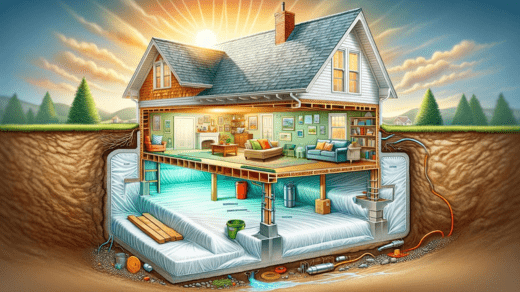Crawlspace encapsulation is a process that involves sealing off the crawl space under your home to prevent moisture and humidity from entering. This method has gained popularity in recent years due to its numerous benefits for homeowners.
Definition and Importance
A crawl space is a shallow area beneath a building that is typically not designed for continuous human occupancy but serves as a crucial part of the structure’s foundation. However, these spaces are susceptible to various issues such as moisture buildup, mold growth, and poor air quality. Crawlspace encapsulation aims to address these issues by creating a barrier between the crawl space and the outside environment.
Common Issues in Crawl Spaces
Unencapsulated crawl spaces are prone to several problems, including:
- Moisture buildup from groundwater or plumbing leaks
- Mold and mildew growth
- Pest infestations
- Poor insulation leading to energy loss
- Increased humidity levels affecting indoor air quality
Benefits of Crawlspace Encapsulation
The process of encapsulating your crawl space offers several advantages for homeowners, including:
Moisture Control
One of the primary benefits of encapsulating your crawl space is moisture control. By sealing off the area and installing a vapor barrier, you can prevent moisture from entering, reducing the risk of mold, mildew, and structural damage.
Improved Air Quality
Encapsulating your crawl space can also lead to improved indoor air quality. By eliminating moisture and preventing mold growth, you can create a healthier living environment for you and your family.
Energy Efficiency
A properly encapsulated crawl space can improve the energy efficiency of your home. By sealing off air leaks and insulating the space, you can reduce heat loss in the winter and keep your home cooler in the summer, ultimately lowering your energy bills.
Process of Crawlspace Encapsulation
The process of encapsulating a crawl space typically involves several steps, including:
Inspection and Assessment
The first step in encapsulating your crawl space is to conduct a thorough inspection to identify any existing issues such as moisture damage, mold growth, or structural problems. A professional contractor can assess the condition of your crawl space and recommend the best course of action.
Cleaning and Preparation
Before encapsulation can begin, the crawl space must be cleaned and prepared. This may involve removing debris, old insulation, and any existing vapor barriers. The space should be thoroughly cleaned and dried to ensure proper adhesion of the encapsulation materials.
Installation of Vapor Barrier
The next step is to install a vapor barrier to seal off the crawl space from the outside environment. This barrier is typically made of a durable plastic material that is resistant to moisture and punctures. It is installed on the floor and walls of the crawl space, creating a continuous barrier against moisture intrusion.
Sealing Vents and Cracks
In addition to installing a vapor barrier, any vents, cracks, or openings in the crawl space must be sealed to prevent air and moisture infiltration. This may involve sealing vents with foam insulation, applying caulk to cracks, and installing vent covers.
Crawl Space Repair Services
In addition to encapsulation, many contractors offer crawl space repair services to address structural issues and damage. These services may include:
Identifying Structural Issues
A professional contractor can inspect your crawl space for signs of structural damage such as sagging floors, cracked walls, or deteriorating support beams. They can recommend repairs to strengthen the foundation and ensure the structural integrity of your home.
Repairing Damaged Insulation
Insulation in the crawl space can become damaged over time due to moisture, pests, or general wear and tear. Repairing or replacing damaged insulation can help improve energy efficiency and prevent heat loss.
Addressing Pest Infestations
Crawl spaces are often susceptible to pest infestations, including termites, rodents, and insects. A pest control professional can assess the extent of the infestation and recommend treatments to eliminate pests and prevent future problems.
Crawl Space Waterproofing
In addition to encapsulation, waterproofing your crawl space is essential for preventing moisture intrusion and protecting your home’s foundation. There are several methods of waterproofing available, including:
Importance of Waterproofing
Waterproofing your crawl space is crucial for preventing water damage, mold growth, and structural problems. By keeping the space dry and free of moisture, you can avoid costly repairs and prolong the life of your home’s foundation.
Methods of Waterproofing
There are various methods of waterproofing a crawl space, including installing a drainage system, applying waterproof coatings to walls and floors, and installing a sump pump to remove excess water. The best method for your home will depend on factors such as soil composition, drainage issues, and climate conditions.
Installing Sump Pumps and Drainage Systems
Sump pumps and drainage systems are commonly used to remove excess water from crawl spaces and basements. These systems collect water that seeps into the space and pump it outside, away from the foundation. Installing a sump pump can help prevent flooding and water damage during heavy rainstorms or periods of high groundwater levels.
Choosing the Right Contractor
When it comes to encapsulating your crawl space, choosing the right contractor is essential. Here are some tips for finding a reputable contractor:
Researching Options
Take the time to research different contractors in your area and read reviews from past customers. Look for companies with experience in crawl space encapsulation and a proven track record of quality work.
Asking for References and Credentials
Before hiring a contractor, ask for references from past customers and verify their credentials. A reputable contractor should be licensed, insured, and certified by professional organizations such as the Basement Health Association.
Getting Multiple Quotes
It’s a good idea to get quotes from multiple contractors to compare prices and services. Be wary of contractors who offer significantly lower prices than their competitors, as this could be a red flag for poor quality workmanship.
Cost Considerations
The cost of encapsulating your crawl space will depend on several factors, including the size of the space, the extent of any existing issues, and the materials used.
Factors Influencing Cost
Common factors that can influence the cost of encapsulation include:
- Size of the crawl space
- Condition of the space
- Type of encapsulation materials used
- Additional services such as repairs or waterproofing
Return on Investment
While encapsulating your crawl space can be a significant upfront investment, it can also provide long-term savings and benefits. By improving energy efficiency, preventing moisture damage, and increasing the lifespan of your home’s foundation, encapsulation can ultimately pay for itself over time.
Maintenance Tips
Once your crawl space has been encapsulated, it’s essential to maintain it properly to ensure long-lasting results. Here are some maintenance tips to keep in mind:
Regular Inspections
Periodically inspect your crawl space for signs of moisture, mold, or pest activity. Catching issues early can help prevent costly repairs down the line.
Addressing Leaks Promptly
If you notice any leaks or water intrusion in your crawl space, address them promptly to prevent damage to your home’s foundation and structural integrity.
Monitoring Humidity Levels
Keep an eye on the humidity levels in your crawl space and take steps to maintain them within the recommended range. This may involve using a dehumidifier or improving ventilation to keep moisture levels in check.
DIY vs. Professional Encapsulation
While some homeowners may be tempted to tackle crawl space encapsulation as a DIY project, it’s often best left to the professionals. Here are some factors to consider when deciding between DIY and professional encapsulation:
Pros and Cons of DIY
DIY encapsulation may be more affordable upfront, but it can be time-consuming and challenging, especially for homeowners with limited experience or technical skills. Mistakes made during the encapsulation process can lead to costly repairs down the line.
When to Hire a Professional
Hiring a professional contractor for crawl space encapsulation ensures that the job is done correctly and efficiently. A professional will have the necessary expertise, tools, and materials to encapsulate your crawl space properly, saving you time and hassle in the long run. Crawlspace encapsulation is a valuable investment for homeowners looking to protect their homes from moisture damage, improve indoor air quality, and increase energy efficiency. By sealing off the crawl space and addressing any existing issues, you can create a healthier, more comfortable living environment for you and your family.










Leave a Reply
You must be logged in to post a comment.